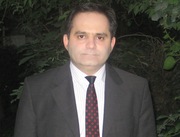ULTRA WEAK SIGNAL PROCESSING FOUNDATION
FOUNDATION OBJECTIVES
ULTRA WEAK SIGNALS
The ultra weak signals are defined as desired communication signals that have receiver power levels below the noise floor. The receiver analog modules including the LNA(s) and the digital modules can not function properly, unless the desired signal power level is effectively boosted to levels above the noise floor.
In the communication receiver, the ultra weak signal processing recovers the desired signal by employing preamplifier analog sub-module before the LNA(s) along with the associated digital processing sub-module.An ultra weak wireless signal at the receiver front end is detectable due to the fluctuation dissipation theorem. The external weak perturbation field provides a systematic change to the receiver electronic transport path current density via canonical correlation function which is related to the transport path current density fluctuations (noise) through the extended (retarded) Langevin analysis.
APPLICATIONS OF ULTRA WEAK SIGNAL PROCESSING
The ultra weak signal processing is required for the following reasons:
To detect wireless signals which are attenuated at levels below the noise floor due to low transmission power, long transmission distance, obstructions in indoor environments, etc.,
To increase the transmission distance for wireless networks that have been traditionally used for short distances without increasing the transmission power,
To allow for the deployment of massive wireless sensors & actuators and their networks at ambient temperature conditions for remote operation,
To increase the capacity for wireless service by operating in a low r.f. power environment and by eliminating the r.f. power overload,
To allow for the inclusion of signal source separation modules in the wireless sets,
To provide a market for massive communication services, and wireless modules that will be included in almost all of the electronic and electromechanical equipment,
To provide dynamic improvements in production, management, service offerings, diversified remote inspections, self employment and other areas
The Adaptive Stochastic Resonance Array (ASRA) Pre-amplification and processing along with Noise Reduction and Signal Source Separation & Deconvolution can be used for ambient temperature (non cryogenic) recovery of Ultra Weak wireless signals which are subject to multiple user co channel interference, as described in the following document:
Ultra Weak Signal Detection by Stochastic Resonance Array, Source Separation & Deconvolution
The Ultra Weak signals ( with power levels below the noise floor ) are the consequence of employing low r.f. power transmission systems which are intended to satisfy the green radio environmental requirement for low electromagnetic emission of radiation.
The ASRA does not require any bandwidth expansion or transmitter pre-processing for its operation, and stochastic resonance quality measures such as signal correlations, standard and quadratic mutual information measures are employed for updating the controlling parameters of the injecting signals and the array weights.
For the Noise Reduction process, second order regression statistics are employed along with data driven state transition predictor matrixes to either maximize the conditional probability distribution of estimated data given the observed noisy data or to perform eigen-decomposition operations.
For the Source Separation and Deconvolution process, the channel is initially estimated by covariance diagonalization of the initial source estimates, but both the channel and the source signals are optimized by subspace projection and by maximizing the sparity in the time frequency domain via the Euclidean distance quadratic mutual information measure.
The Adaptive Stochastic Resonance Array and Adaptive Transport Path Array ultra weak signal processing concepts are covered in the following document:

